Abu Simbel: The Temples That Moved
The temples of Abu Simbel are two very large sets of stone carvings created during the reign of the famous pharaoh Ramses II. In the main, the temples depict events in the Battle of Kadesh. 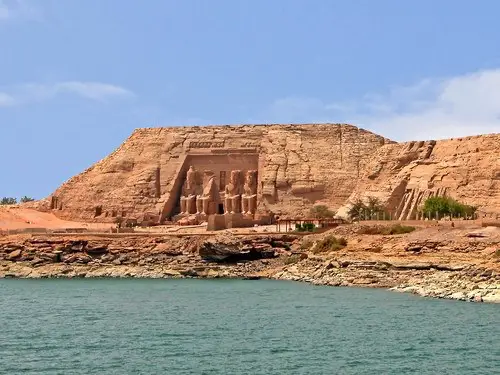
It took 20 years to build the two temples at Abu Simbel. Construction began in 1244 B.C., three years after the famous battle, and ended about 1224 B.C. One main purpose of building the temples was Ramses' desire to celebrate what he saw as his victory in the epic battle; indeed, carved into the base of the temple and at various points inside are illustrations showing the battle itself and bound prisoners captured by the Egyptians. The temples themselves resided on the border between Egypt and Nubia, its neighbor to the south. 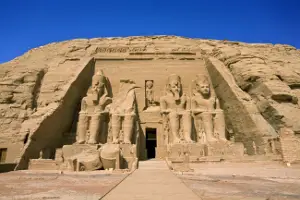
The Great Temple, which is 98 feet tall and 115 feet long, is dedicated to the god Re-Horakhty. At its entrance is a carved depiction of Ramses II worshiping that god and four 65-foot-tall stone statues showing Ramses himself, wearing a crown as he sits on a throne. At this feet are carvings of some of his wives and some of his children. Inside the temple are a series of carvings showing Ramses and Nefertari, his favorite wife. Within an inner sanctuary are statues of the gods Amen, Ptah, and Ra; Ramses himself is seated along The Small Temple, dedicated to the goddess Hathor, stands 40 feet high and is 92 feet long. The temple honors Nefertari, especially in her size: She is as tall as her As the Egyptian civilization declined, so did the belief that such temples as those at Abu Simbel needed upkeep. The winds and sands buried a significant part of the temples and their great statues, and the great carvings faded into obscurity. A Swiss explorer in the 19th Century rediscovered the great temples, and excavations followed not long after. It was in the 20th Century that the Egyptian government proposed a plan that many people questioned. In the 1960s, plans were moving forward with construction of the Aswan High Dam, on the Nile and also involving Lake Nasser. Abu Simbel was more than 150 miles away. However, government officials were concerned that the resulting rise in the water level at The name Abu Simbel comes from a young Egyptian boy who led the Swiss explorer, Johann Burckhardt, to the site. Burchkardt and a fellow explorer, the Italian Giovanni Belzoni, did the initial excavations in 1817. |
|
Social Studies for Kids
copyright 2002–2024
David White



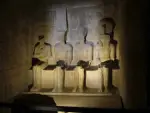 those gods. Some historians think that the location and alignment of the Great Temple are related to the position of the Sun because on February 22 and October 22, sunlight illuminates all of those statues except Ptah, the god of the underworld. According to some accounts, Ramses' birth and coronation were on those dates.
those gods. Some historians think that the location and alignment of the Great Temple are related to the position of the Sun because on February 22 and October 22, sunlight illuminates all of those statues except Ptah, the god of the underworld. According to some accounts, Ramses' birth and coronation were on those dates.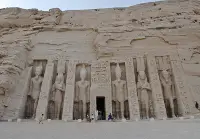 husband, which was not the norm. Four of the six statues at the temple entrance depict Ramses II; the other two depict Nefertari. This was the second time that a pharaoh had built a temple that was dedicated to his wife; the first to do this was
husband, which was not the norm. Four of the six statues at the temple entrance depict Ramses II; the other two depict Nefertari. This was the second time that a pharaoh had built a temple that was dedicated to his wife; the first to do this was 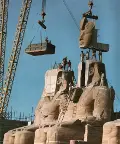 Lake Nasser would put Abu Simbel underwater. The government proposed to take the temples apart and move them to higher ground. During a period of four years, a large group of workers took the temples apart and moved them 40 feet up, reassembling them into a man-made mountain so as to appear that they were cut out of the rock originally. Thus, the interior of the temples extend into the mountain, in the case of the Great Temple for more than 200 feet.
Lake Nasser would put Abu Simbel underwater. The government proposed to take the temples apart and move them to higher ground. During a period of four years, a large group of workers took the temples apart and moved them 40 feet up, reassembling them into a man-made mountain so as to appear that they were cut out of the rock originally. Thus, the interior of the temples extend into the mountain, in the case of the Great Temple for more than 200 feet.
